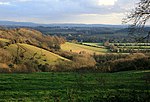Municipal Ground

The Municipal Ground (also known as Anstey Park) was a cricket ground in Alton, Hampshire. The ground was constructed as a result of the efforts of G.J. Poole, the headmaster of a local Grammar School. Constructed by 1899, the Hampshire Second XI played there in the grounds first recorded match in that year, while Hampshire later played one first-class match at the ground, against the touring South Africans in 1904. The match ended in a South African victory by an innings and 19 runs, during which South African batsman Louis Tancred was dismissed for 99 by Hesketh Hesketh-Prichard, while in Hampshire's first-innings Johannes Kotze took a five wicket haul with figures of 5 for 66. Whilst the ground still exists, it is instead used as a venue for rugby union matches.
Excerpt from the Wikipedia article Municipal Ground (License: CC BY-SA 3.0, Authors, Images).Municipal Ground
Anstey Park, East Hampshire
Geographical coordinates (GPS) Address Nearby Places Show on map
Geographical coordinates (GPS)
| Latitude | Longitude |
|---|---|
| N 51.1591 ° | E -0.9632 ° |
Address
Anstey Park
GU34 2NB East Hampshire
England, United Kingdom
Open on Google Maps




